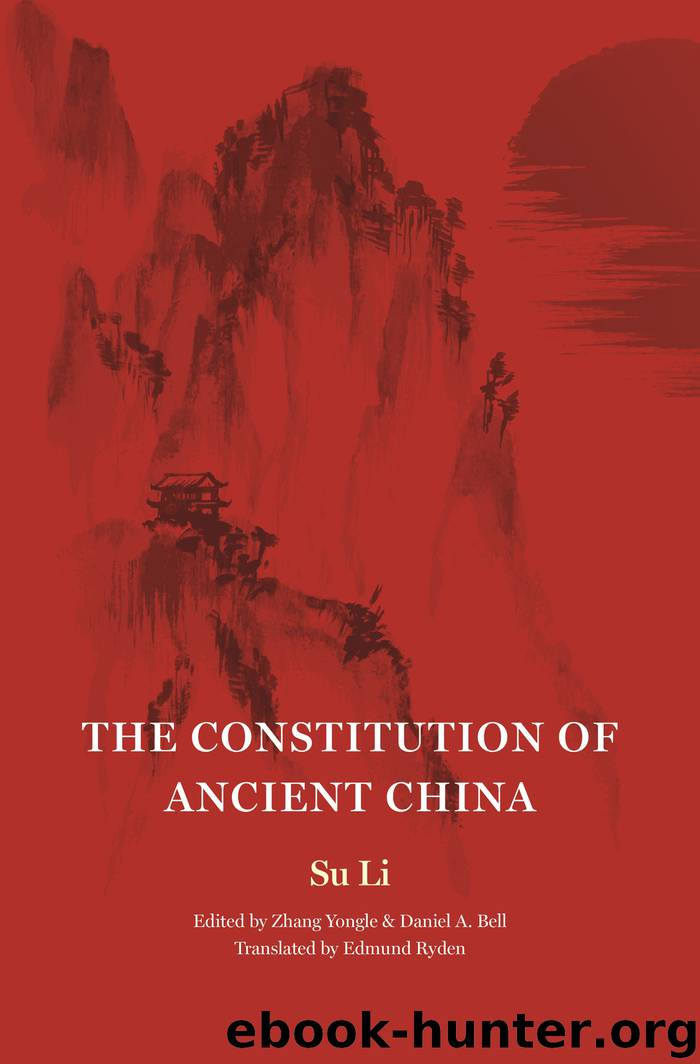The Constitution of Ancient China by Su Li

Author:Su Li
Language: eng
Format: epub
Publisher: Princeton University Press
Published: 2018-01-19T16:00:00+00:00
Numerology and Offices
The use of symbolic numerology to set out the relationships between government posts and the universe was later systematized and expressed more fully than in the old-text version of the classic Rites of Zhou. The links between heaven, formalization of the institutions, and the law were formed on the common moral/political scaffolding of the rites. Unlike the rites, the institutions and the law needed an external source of legitimacy. In the Western and Eastern Han, there was a distinction between new-text and old-text scholarship, but there was one thread handed down in the theory of the monarchy within the study of the classics. When the Eastern Han was founded, the rulers cut back the power of the feudal lords and kings by reissuing the law against forming cliques promulgated under Emperor Wu. This restricted the activities of the lords and kings by requiring them to keep to a system of norms, such as that they must not use the rites of the Son of Heaven and, in appointing ministers, they had to use Han institutions. They had to pay a regular tribute tax to the court. Without a tiger tally they could not send out troops. They were not permitted to pan for salt or smelt iron within their states for their own use. They were not to form private cliques within the state or form private links with their in-laws, and so on.42 In this sense, the absolute nature of heaven in Eastern Han thought and its power to decide things still affected relationships between the Son of Heaven and the feudal lords and officials.43 The original title of the Rites of Zhou was the Officialdom of Zhou, and it is this name that is first recorded in the Records of the Historian. Later in the bibliography of the Han History, a Classic of the Officialdom of Zhou in six pian is recorded, showing that the book already was considered a classic in the Han dynasty. Tradition holds that the Rites of Zhou dates from the mid-second century BC, but it was known only in Han times and now contains many ideas from Liu Xin and Wang Mang.44 Proof of this comes from an attempt by Liu Xin (46 BC–23 CE) to gain the post of a scholar-official for the Rites of Zhou.45
The main characteristic of the Rites of Zhou is its use of numbers to regulate the system of offices and thereby express its political ideals. As was noted earlier, the importance of numbers in the ritual order can be traced back to the tradition of divination in the Shang and Zhou dynasties and attained its apogee in the writings of the yin-yang school. With the prominence accorded to natural science in the Han dynasty, “number” increased in importance as an expression of knowledge of nature whereby the will of heaven in relation to human affairs could be thought of, something that we might well call a form of proto-science. The Rites of Zhou uses the
Download
This site does not store any files on its server. We only index and link to content provided by other sites. Please contact the content providers to delete copyright contents if any and email us, we'll remove relevant links or contents immediately.
Day by Elie Wiesel(2700)
The Age of Genius by A. C. Grayling(2460)
Gideon's Spies: The Secret History of the Mossad by Gordon Thomas(2291)
The Gulag Archipelago (Vintage Classics) by Aleksandr Solzhenitsyn(2031)
FATWA: Hunted in America by Pamela Geller(1958)
Columbine by Dave Cullen(1798)
Men Explain Things to Me by Rebecca Solnit(1662)
The Rule of Law by Bingham Tom(1632)
Anatomy of Injustice by Raymond Bonner(1593)
Examples & Explanations: Administrative Law by William F. Funk & Richard H. Seamon(1586)
Three Cups of Tea by Greg Mortenson(1560)
That Every Man Be Armed by Stephen P. Halbrook(1524)
The Source by James A. Michener(1520)
ADHD on Trial by Michael Gordon(1512)
Gideon's Spies by Gordon Thomas(1455)
Future Design by Unknown(1453)
Palestinian Walks by Raja Shehadeh(1430)
Constitutional Theory by Carl Schmitt(1397)
Nothing to Envy by Barbara Demick(1368)
